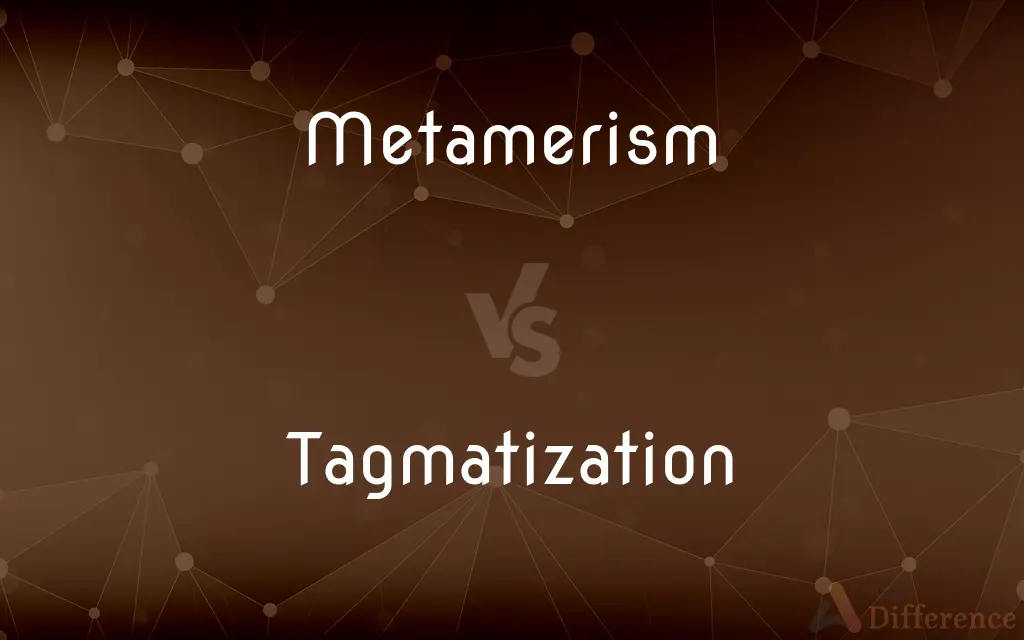Metamerism vs. Tagmatization — What's the Difference?
By Tayyaba Rehman & Urooj Arif — Updated on April 22, 2024
Metamerism involves the segmentation of an organism's body into similar units, common in annelids; tagmatization refers to the specialization of these segments into distinct functional groups seen in arthropods.

Difference Between Metamerism and Tagmatization
Table of Contents
ADVERTISEMENT
Key Differences
Metamerism is a biological phenomenon observed in various animal phyla, where the body is divided into a series of repetitive segments, each potentially containing similar structures such as muscles, nerves, and blood vessels. While, tagmatization represents an evolutionary progression where these segments are grouped into functional units or tagmata, each serving a different purpose, such as the head, thorax, and abdomen in insects.
In metamerism, the emphasis is on the repetition and similarity across segments, which can be crucial for the organism's flexibility and locomotion. For example, in earthworms, metamerism allows for the coordinated contraction and expansion of segments, aiding in movement through soil. Whereas, tagmatization enhances the organism's specialization; in arthropods like spiders and insects, different body regions are adapted for specific functions, such as sensory processing, feeding, and locomotion.
The anatomical structure within metamerically segmented organisms tends to be more uniform across segments, providing redundancy and increased survival prospects from damage to any single segment. On the other hand, tagmatization often involves significant morphological differentiation between different tagmata, reflecting the distinct roles each plays, from sensory and neural functions in the head to reproductive and digestive functions in the abdomen.
Metamerism can be seen as a foundational organizational principle, from which tagmatization likely evolved. While metamerism focuses on the division of the body into multiple similar units, tagmatization takes this a step further by organizing these units into complex structures with specialized functions.
Metamerism and tagmatization, while distinct, are interlinked aspects of the body plan evolution in bilaterians, particularly invertebrates. Metamerism provides the template of repetitive segments, and tagmatization modifies this template to enhance functional specialization and efficiency.
ADVERTISEMENT
Comparison Chart
Definition
Division of the body into repeated segments
Specialization of segments into distinct functional units
Key Examples
Annelids (e.g., earthworms), some arthropods
Arthropods (e.g., insects, crustaceans)
Biological Role
Provides flexibility and redundancy
Enhances functional specialization
Evolutionary Significance
Represents a basic form of body organization
Represents an advanced form of body specialization
Structural Uniformity
High uniformity across segments
High differentiation between grouped segments
Compare with Definitions
Metamerism
Helps in distributing body functions along a series of repeated organs.
In leeches, each segment houses identical nerve and muscle structures.
Tagmatization
Common in arthropods, facilitating complex behaviors and adaptations.
The thorax of bees is specialized for flying and carrying pollen.
Metamerism
Common in many worms and some early developmental stages of other animals.
The larvae of many insects exhibit metamerism.
Tagmatization
The specialization of body segments into distinct functional units.
Insects show tagmatization with separate head, thorax, and abdomen.
Metamerism
Facilitates regeneration in some species.
Some annelids can regenerate lost segments due to their metamerism.
Tagmatization
Reflects an advanced evolutionary adaptation to ecological niches.
Crustaceans have tagmatized bodies adapted to aquatic life.
Metamerism
A biological feature where the body is segmented into similar units.
The metamerism in earthworms allows them to move efficiently through soil.
Tagmatization
Drives evolutionary diversification in complex organisms.
Tagmatization has led to a variety of insect body forms adapted to different environments.
Metamerism
Can contribute to the complexity of body plans in evolutionary terms.
Metamerism in ancestral species is a precursor to more complex body structures.
Tagmatization
Enhances the organism’s efficiency by dividing labor among different body parts.
The abdomen in many insects is primarily for digestion and reproduction.
Metamerism
Metamerism may refer to: Metamerism (biology), in zoology and developmental biology, the property of having repeated segments, as in annelids Metamerism (color), in colorimetry, a kind matching of the colors that, based on differences in spectral power distribution, do not actually match In chemistry, the chemical property of having the same proportion of atomic components in different arrangements (obsolete, replaced with isomer). In organic chemistry, compounds having the same molecular formula but different number of carbon atoms (alkyl groups) on either side of functional group (e.g.
Tagmatization
(zoology) The active process whereby tagmosis occurs
Metamerism
The condition of having the body divided into metameres, apparent in certain animals only in the early embryonic stages of development.
Metamerism
(biology) The segmentation of the body into similar discrete units.
Metamerism
(psychology) The matching of a perceived attribute between objects with differing physical attributes.
Metamerism
(colorimetry) The matching of apparent color of objects with different spectral power distributions.
Metamerism
(chemistry) Structural isomerism.
Metamerism
The symmetry of a metameric structure; serial symmetry; the state of being made up of metameres.
Metamerism
The state or quality of being metameric; isomerism due to different bonding patterns in two substances having the same molecular formula. Contrasted with steroisomerism or optical isomerism. Also, the relation or condition of metameric compounds.
Common Curiosities
What is metamerism in biology?
Metamerism refers to the division of an organism's body into a series of similar segments.
How does metamerism affect an organism’s locomotion?
It allows for coordinated movements of segments, as seen in the undulating motion of worms.
What is the role of tagmatization in insect anatomy?
It divides the insect body into regions optimized for sensory input, movement, and reproduction.
Which animals typically show tagmatization?
Arthropods, like insects and crustaceans, exhibit tagmatization with specialized body regions.
Why is metamerism important in certain animals?
It allows for flexibility, redundancy in structure, and in some cases, regenerative capabilities.
How does tagmatization differ from metamerism?
Tagmatization involves the specialization of these segments into distinct functional units or regions.
Can you give an example of an animal with metamerism?
Earthworms are a classic example, with their bodies divided into numerous similar segments.
Does metamerism occur in humans?
Humans do not exhibit true metamerism, but the concept of segmentation is reflected in the spinal vertebrae and ribs.
How do these features influence evolutionary biology?
They illustrate different evolutionary strategies for body plan development and specialization.
What evolutionary advantage does tagmatization provide?
It enhances functional specialization, allowing different body parts to perform specific roles more effectively.
How do metamerism and tagmatization impact an organism’s survival?
Both contribute to survival by enabling flexibility, specialization, and adaptation to environments.
Can tagmatization be observed in aquatic animals?
Yes, particularly in aquatic arthropods like lobsters and shrimp.
Are there any disadvantages to these body structures?
While offering many advantages, specialization (tagmatization) can limit the organism's flexibility to adapt to new environments.
Is tagmatization a common feature in all segmented animals?
No, it is primarily seen in arthropods, whereas other segmented animals like annelids mainly exhibit metamerism.
What structural differences are typical between metamerism and tagmatization?
Metamerism involves repeated, similar segments, while tagmatization involves grouping these into functionally different units.
Share Your Discovery

Previous Comparison
Capellini vs. Vermicelli
Next Comparison
Specimen vs. SampleAuthor Spotlight
Written by
Tayyaba RehmanTayyaba Rehman is a distinguished writer, currently serving as a primary contributor to askdifference.com. As a researcher in semantics and etymology, Tayyaba's passion for the complexity of languages and their distinctions has found a perfect home on the platform. Tayyaba delves into the intricacies of language, distinguishing between commonly confused words and phrases, thereby providing clarity for readers worldwide.
Co-written by
Urooj ArifUrooj is a skilled content writer at Ask Difference, known for her exceptional ability to simplify complex topics into engaging and informative content. With a passion for research and a flair for clear, concise writing, she consistently delivers articles that resonate with our diverse audience.
















































